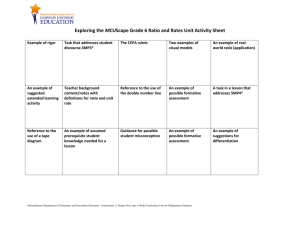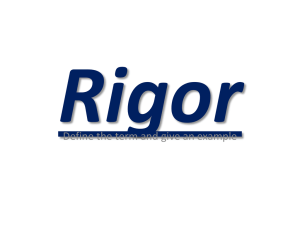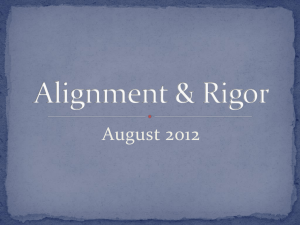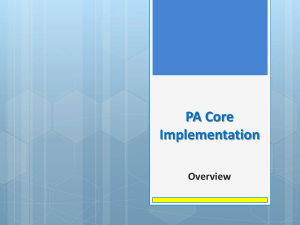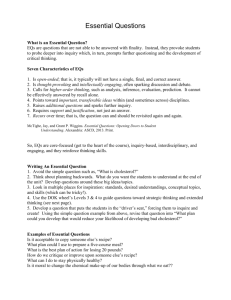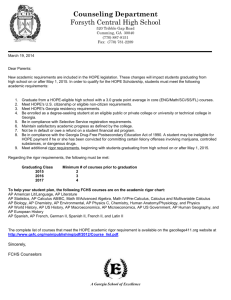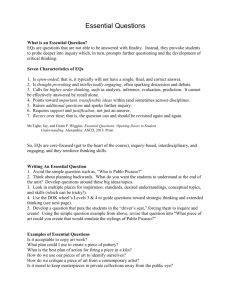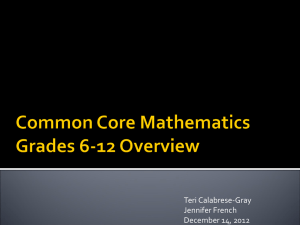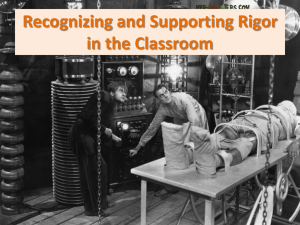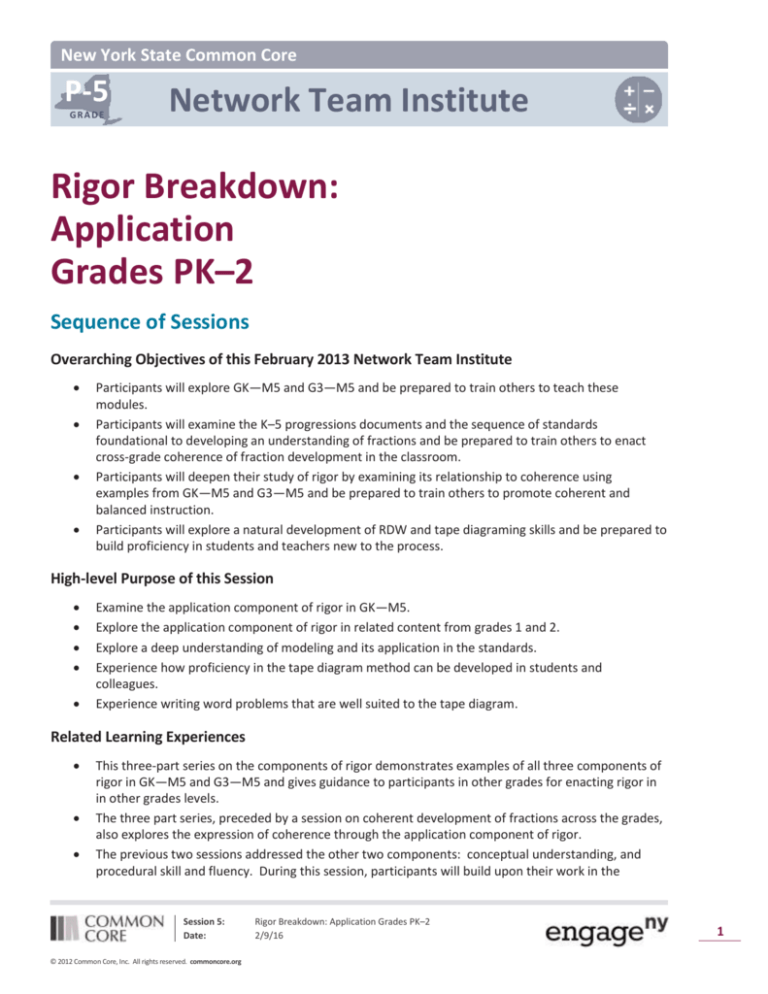
New York State Common Core
P-5
GRADE
Network Team Institute
Rigor Breakdown:
Application
Grades PK–2
Sequence of Sessions
Overarching Objectives of this February 2013 Network Team Institute
Participants will explore GK—M5 and G3—M5 and be prepared to train others to teach these
modules.
Participants will examine the K–5 progressions documents and the sequence of standards
foundational to developing an understanding of fractions and be prepared to train others to enact
cross-grade coherence of fraction development in the classroom.
Participants will deepen their study of rigor by examining its relationship to coherence using
examples from GK—M5 and G3—M5 and be prepared to train others to promote coherent and
balanced instruction.
Participants will explore a natural development of RDW and tape diagraming skills and be prepared to
build proficiency in students and teachers new to the process.
High-level Purpose of this Session
Examine the application component of rigor in GK—M5.
Explore the application component of rigor in related content from grades 1 and 2.
Explore a deep understanding of modeling and its application in the standards.
Experience how proficiency in the tape diagram method can be developed in students and
colleagues.
Experience writing word problems that are well suited to the tape diagram.
Related Learning Experiences
This three-part series on the components of rigor demonstrates examples of all three components of
rigor in GK—M5 and G3—M5 and gives guidance to participants in other grades for enacting rigor in
in other grades levels.
The three part series, preceded by a session on coherent development of fractions across the grades,
also explores the expression of coherence through the application component of rigor.
The previous two sessions addressed the other two components: conceptual understanding, and
procedural skill and fluency. During this session, participants will build upon their work in the
Session 5:
Date:
© 2012 Common Core, Inc. All rights reserved. commoncore.org
Rigor Breakdown: Application Grades PK–2
2/9/16
1
NYS COMMON CORE MATHEMATICS PD
Rigor Breakdown: Application
previous sessions.
Key Points
Application is called for in the PK–5 standards in three distinct ways: word problems, real-world
problems, and modeling.
Each of these areas of application can be used to coherently bridge gaps in prerequisite knowledge.
Use of tape diagrams, as described in the progressions documents provides visualization of
relationships between quantities thereby promoting conceptual understanding, provides coherence
through standards from Grade 1 through Grade 7, and supports standards for mathematical practice.
Proficiency in the tape diagram method can be developed in students and teachers new to the
process through a natural development of problems and representations.
Content knowledge directed by the standards and the progressions is required to provide coherent
and balanced instruction.
Many activities that promote application, also address the Standards of Mathematical Practice.
Session Outcomes
What do we want participants to be able to do as a result of this session?
Recognize application activities in GK—M5.
Select and design application problems for use in lessons related to the development of fractions
across the grades.
Proficiently use and teach the tape diagraming method in application problems.
Understand and convey to others the importance of content knowledge directed by the standards
and progressions in delivering coherent and balanced instruction.
How will we know that they are able to do this?
Participants will report preparedness for implementing application activities, across the grades, as
described in A Story of Units.
Participants will share their grasp of application, and specifically modeling, and its importance with
colleagues, providing examples of how it is addressed in A Story of Units.
Session 5:
Date:
© 2012 Common Core, Inc. All rights reserved. commoncore.org
Rigor Breakdown: Application Grades PK–2
2/9/16
2
Rigor Breakdown: Application
NYS COMMON CORE MATHEMATICS PD
Session Overview
Section
Time
Opening
0:00-0:10
(10 min)
Application
in GK–M5
0:10-0:20
(10 min)
Application –
Modeling in the
Standards
0:20-0:40
(20 min)
Building Proficiency
with Tape Diagrams
0:40-1:30
(50 min)
Application –
Writing Word
Problems & RealWorld Problems
1:30-1:50
(20 min)
Closing
1:50-2:00
(10 min)
TOTAL TIME
120 min
Overview
Link to previous sessions; frame the
session, referencing the agenda.
Provide an overview of application
as defined in the Shifts and
Publishers’ Criteria.
Review the flow and objectives of
this session.
Watch a video of an application
activity from GK–M5.
Examine other application examples
from GK–M5.
Explore the coherence of modeling
from PK-12.
Enhance understanding of modeling
by examining the two categories of
modeling and their representation
in the Standards.
Work through a series of problems
designed to build proficiency with
tape diagrams.
Reflect on individual complexities of
word problems.
Practice writing word problems for
topics related to fraction
development in grades 1 and 2.
Examine the considerations when
writing word problems and realworld problems.
Summarize key points.
Reflect on the role of application in
coherent and balanced instruction.
Session 5:
Date:
© 2012 Common Core, Inc. All rights reserved. commoncore.org
Prepared Resources
Facilitator Preparation
Session PowerPoint
Review session notes and
PowerPoint presentation.
Grade K—Module 5
Video Clip: GK—M5 Application
Download and review clip.
K–2 Standards Calling for Word
Problems
Rigor Breakdown: Application Grades PK–2
2/9/16
3
NYS COMMON CORE MATHEMATICS PD
Rigor Breakdown: Application
Session Roadmap
Opening
Time: 0:00-0:10
[10 minutes] In this section, you will…
Link to previous sessions; frame the session, referencing the agenda.
Provide an overview of application as defined in the Shifts and Publishers’ Criteria.
Review the flow and objectives of this session.
Materials used include:
Session PowerPoint
(SLIDE 1) This three-part series on the components of rigor demonstrates examples of all three components of rigor in
GK—M5 and gives guidance to participants on enacting rigor in in other grades levels, specifically grades 1 and 2.
The three-part series, preceded by a session on coherent development of fractions across the grades, also explores the
expression of coherence through the application component of rigor.
The previous two sessions addressed the other two components: conceptual understanding, and procedural skill and
fluency. During this session, participants will build upon their work in the previous sessions.
(SLIDE 2) Let’s begin by looking at our new objectives.
Examine the application component of rigor in GK—M5.
Explore the application component of rigor in related content from grades 1 and 2.
Explore a deep understanding of modeling and its application in the standards.
Experience how proficiency in the tape diagram method can be developed in students and colleagues.
Experience writing word problems that are well suited to the tape diagram.
(SLIDE 3) Let’s begin by revisiting what is meant by application. Here we have an excerpt from the Instructional Shifts.
Take 30 seconds to read and reflect on the excerpt. (Allow up to 1 minute for participants to read and reflect.)
What stands out to you about this excerpt? Is anyone willing to share? (Allow 2-3 participants to contribute. If no one
suggests it, put forth the following observation.)
How about the fact that students are being asked to know what to do with an application problem even when they are
given no guidance. It reads, “choose the appropriate concept… even when not prompted to do so.” Isn’t that what
true problem solving is? Is it really problem solving if you are merely doing what someone else has guided you to do, or
doing the same procedure as the problem that was just demonstrated only this time with different numbers?
Let’s keep this idea in mind as we go through this session – our objective is to prepare students with the understanding
and application experiences needed for true problem solving. When we practice and assess problem solving, we need
to be careful that we are not inadvertently giving students too much guidance. If you are always setting the students
Session 5:
Date:
© 2012 Common Core, Inc. All rights reserved. commoncore.org
Rigor Breakdown: Application Grades PK–2
2/9/16
4
NYS COMMON CORE MATHEMATICS PD
Rigor Breakdown: Application
up with guidance and predictability, are you really assessing their readiness to choose an appropriate concept when not
prompted to do so?
(SLIDE 4) This session, like the previous two, will start off with a quick look at application, and specifically modeling in
Grade K—Module 5. Next we will deepen our understanding of modeling by looking at the two main uses of modeling
and how they occur in the standards of PK-12. Then we will embark on a sequence of problems designed to build
proficiency with tape diagrams. And, finally we will have our hand at writing word problems and real-world problems
related to the grade 1 and 2 lessons we’ve been studying in the previous sessions.
Application in Grade K—Module 5
Time: 0:10-0:20
[10 minutes] In this section, you will…
Watch a video of an application activity from GK–M5.
Examine other application examples from GK–M5.
Materials used include:
Grade K—Module 5
Video Clip: GK—M5 Application
(SLIDE 5) Those of you in attendance at our last NTI may recall that the PK-5 standards call for application in three
ways. Can anyone share what those ways are? (Allow for contributions ensuring that the three areas are accurately
reflected as: word problems, real-world problems, and modeling.)
(CLICK TO ADVANCE BULLETS.)
Application in GK – M5 is largely addressed through modeling. Since this module stops short of adding or subtracting
fractions, the bulk of application is through modeling the fractions in meaningful and visual ways and connecting it to
measurement.
(SLIDE 6) We are going to watch a video of an exercise from GK—M5 where students are developing the skill of
representing a teen number as a group of 10 ones and some ones.
While you watch the video, take note of the delivery style of the exercise. After the video clip, you will
have a chance to share your observations.
(SLIDE 7) (Play Video Clip: GK—M5 Application.)
(SLIDE 8) Take a moment to consolidate your thoughts on the reflection question posed before the
video. Who would like to share their observations about the way the exercise was delivered?
(SLIDE 9) Take 2-3 minutes to look through the application section of the lessons in GK – M5. What models sets of
identical items are being used? (Allow 2-3 minutes, and then call on volunteers to share their findings. Results should
Session 5:
Date:
© 2012 Common Core, Inc. All rights reserved. commoncore.org
Rigor Breakdown: Application Grades PK–2
2/9/16
5
NYS COMMON CORE MATHEMATICS PD
Rigor Breakdown: Application
include towers of unifix cubes.)
(SLIDE 10) Let’s review some key points from this section.
Application is called for in the PK–5 standards in three distinct ways: word problems, real-world problems, and
modeling.
Each of these areas of application can be used to coherently bridge gaps in prerequisite knowledge.
Many activities that promote application, also address the Standards of Mathematical Practice.
Application – Modeling in the Standards
Time: 0:20-0:40
[20 minutes] In this section, you will…
Explore the coherence of modeling from PK-12.
Enhance understanding of modeling by examining the two categories of modeling and their representation in
the Standards.
Materials used include:
(SLIDE 11) If you were in attendance for Day 2 of this NTI, you have heard a great deal about modeling and the
modeling process as it develops over grades 6–12. In this session, we’ve been using the word modeling in the context
of promoting understanding through concrete and visual models and in reference to application. This use of the word
is not unrelated to the use of the term for higher grades.
Indeed, modeling is an area that begins in PK and continues to be developed and used through high-school and beyond
into college and career. In line with today’s theme of coherence, we’re going to deepen our understanding of
modeling, considering the two types of modeling and how those types are developed through the Standards from PK to
12.
(SLIDE 12) The fact that there is more than one use or meaning of the term modeling can make it difficult to define.
Before we look at this distinction between the two uses, think of an example of modeling that you might share with a
colleague who asked you, ‘What is modeling?’ (Allow for 1 minute before proceeding to the next slide.)
(SLIDE 13) The purpose and method of modeling falls into two categories: descriptive modeling and analytic modeling.
Descriptive modeling is using concrete materials or pictorial displays to study quantitative relationships. The materials
or pictures provide for ease of visualization and communication, and highlight attributes and relationships of quantities
and measures.
Analytic modeling can also make use of graphical representations, but it is primarily thought of as using equations or
statistical representations that lead to an analysis (possibly involving manipulation of the equations for example). The
analysis is used to reveal otherwise hidden or non-obvious characteristics of the relationships between the variables.
Session 5:
Date:
© 2012 Common Core, Inc. All rights reserved. commoncore.org
Rigor Breakdown: Application Grades PK–2
2/9/16
6
NYS COMMON CORE MATHEMATICS PD
Rigor Breakdown: Application
Think back to your example of a modeling that you composed in the last slide. Which category best describes its
purpose?
The distinction is not always obvious, but it is a useful distinction none-the-less, as it clarifies what can seem
disconnected uses of the term modeling. Let’s continue to examine each category.
(SLIDE 14) Examples of descriptive modeling in the Standards begin in PK and K with students modeling objects in their
environment using geometric shapes and figures.
The next example is one that for me can in some cases cross over into analytic modeling – modeling forms of addition
and subtraction situations using concrete materials or diagrams. If students’ use of materials or diagrams is merely a
demonstration of what is already accessible, then I would say it fits well into the descriptive modeling category.
However, one might argue that this is the very beginning of something more analytical, if they are using the model to
decide on and complete an operation that reveals something not previously known or obvious.
Continuing on through the grades, place value models, multiplication models, visual fraction models, and the number
line model all lead to more clear representation of quantities.
In middle-school, high-school, and beyond, tables and graphs of data as well as 2-D and 3-D models using geometry
software or other software continue to display relationships of quantities and measurements that are helpful and fall
into the category of descriptive modeling.
(SLIDE 15) Analytic modeling suggests that once you apply the model, you are empowered with new tools that come
with that model – such as algebraic methods. In some cases those algebraic methods are accessible through tape
diagrams. That being said, what more often comes to mind as analytic modeling is the use of equations, functions, or
statistical and probability models.
(SLIDE 16) Take a moment now to share with your partner about what the key difference is between descriptive and
analytic modeling.
(CLICK TO ADVANCE 2nd BULLET.)
So the key difference here is in whether the modeling of the situation is leading to an analysis that reveals something
previously inaccessible, or is it simply facilitating clarity through visualization of the quantities or measurements.
(SLIDE 17) The high school standards have a specific modeling process that they expect students to become proficient
with during grades 9-12. While participants who were here for Day 2 of this NTI have already explored this process, for
those of you who were not here, it is worthwhile to review this process in the interest of coherence and in knowing
what you are preparing students for down the line.
Students are provided with a sometimes incomplete description of a situation for which there is a problem or
opportunity for improvement, or, they are given an undefined problem that they devise a plan for and solve. The
students are asked to independently reason through what features and relationships (assumptions, constraints) in the
situation are relevant and need to be modeled. Next they are asked to formulate the model to represent the relevant
relationships. That brings them a series of analytic tools to apply to their model to come to some conclusion about how
to improve or solve the problem they have detected and modeled. The solution that is arrived at should then be
Session 5:
Date:
© 2012 Common Core, Inc. All rights reserved. commoncore.org
Rigor Breakdown: Application Grades PK–2
2/9/16
7
NYS COMMON CORE MATHEMATICS PD
Rigor Breakdown: Application
translated from the symbols of the model back into the context of the problem.
Since models are inherently ‘wrong’ or, not an exact match of reality, the results should then be validated by comparing
them to the situation and asking if this solution makes sense. If it doesn’t make sense, they may need to improve their
model, perhaps adjusting some assumptions and repeat. Finally when they arrive at a solution that seems to make
sense, they must report their findings including a ‘disclaimer’ of sorts listing what assumptions and approximations
were made in formulating the model that produced this result.
Competence in this cycle and in the higher order thinking that is required and developed through learning modeling is
vitally important to the long term success of students not only in college but in career.
How does knowing about the modeling cycle and expectations for high school students inform our view of modeling in
grades PK-5?
(SLIDE 18) Take a moment now to reflect on how knowledge of the modeling cycle and expectations for high school
students inform our approach to modeling in grades PK-5.
Is anyone willing to share their thoughts?
(SLIDE 19) Let’s review some key points from this section. (CLICK TO ADVANCE EACH BULLET.)
Application is the students’ ability to use relevant conceptual understandings and appropriate strategies and
tools even when not prompted to do so.
Modeling can be descriptive, using concrete materials or pictorial displays to study quantitative relationships,
or analytical, using equations or statistical representations to provide analysis of the relationships between
variables (quantities).
A curriculum rich in application, including modeling, provides coherence from PK – 12 and beyond, to college
and career.
Building Proficiency with Tape Diagrams
Time: 0:40-1:30
[50 minutes] In this section, you will…
Work through a series of problems designed to build proficiency with tape diagrams.
Reflect on individual complexities of word problems.
Materials used include:
(SLIDE 20) The next session is designed in consideration of the fact that proficiency in tape diagramming will need to be
developed for both students and teachers who have not been working with them in prior years. We’ve prepared a
series of problems to walk us through how use of tape diagrams begins and how new complexities are worked in one at
a time.
(SLIDE 21) Before we begin, consider that the use of tape diagrams goes hand in hand with word problems and that our
Session 5:
Date:
© 2012 Common Core, Inc. All rights reserved. commoncore.org
Rigor Breakdown: Application Grades PK–2
2/9/16
8
NYS COMMON CORE MATHEMATICS PD
Rigor Breakdown: Application
delivery should promote perseverance in problem solving and develop independence in students’ ability to work
through problems. We want the process and the questioning to be naturally internalized by students. The repeated
pattern of reading, questioning, drawing, labeling and finally writing an answer is commonly referred to as RDW, for
Read, Draw, Write.
(SLIDE 22) There are two basic forms of the bar diagram model. The first form is sometimes called the part-whole
model; it uses bar segments placed end-to-end; all segments together form the whole quantity. The second form,
sometimes called the comparison model, uses two or more bars stacked in rows that are left-justified; in this form the
whole is depicted off to the side.
We will reflect on the nuances of the two forms when we have finished this section. For now, you can use whichever
works best for you with any given problem.
(SLIDE 23) In the very early grades, we count out objects, and do comparisons of quantities (e.g., Who has more? Who
has fewer? How many more? How many fewer?). It is important that students see groups of objects in many
arrangements and learn to instantly recognize quantities up to 5 or 6. But it is equally important that we begin
modeling for students the laying out of objects in an organized fashion that previews bar modeling, in both the end-toend fashion and the comparison fashion. This is especially appropriate when working with word problems of addition
and subtraction.
As the teacher, model a comparison of two quantities in the manner that makes the comparison easiest to see. It is not
recommended to become overly structured in forcing students to model it a certain way every time. The suggestion,
“This time can you lay yours out like I have mine” will serve to build this habit of setting up items in rows to support
counting, comparison, and the model of using rectangular bars.
(SLIDE 24) The transition into bar diagrams requires transitioning from sets of actual objects to pictures of objects, to
bar-shaped pictures that still depict individual objects, and then to rectangular bars with no distinct markings of
individual items.
A benefit of using rectangular bars without the markings of individual items is that students can now model nondiscrete quantities – like measurements of distance or weight – as well as being able to represent unknown quantities.
(SLIDE 25) Beginning the tape diagram process can sometimes bring rise to student comments of, “But, I can solve this
without a diagram.” In general you can convey to students that you are requiring them to explain their work so that
you understand their thinking and so that they can share their thinking with their friends and justify their answers. In
particular, if you are introducing tape diagrams to a 3rd, 4th or 5th grade student, you may find it helpful to simply say,
“Bear with me – by the end of the week/month/year I promise you will see the value in this process.”
(EXAMPLE 1) Let’s consider the first example. (The indented text is to be read as though leading a class of students,
thereby modeling for participants how this delivery can be executed in the classroom.)
Read the first sentence with me. “Sara has 5 stamps.”
Let’s draw something.
Make your drawing look like mine. (Demonstrate on a flip chart, and then refer to the PPT slide to see
completed drawing.)
Session 5:
Date:
© 2012 Common Core, Inc. All rights reserved. commoncore.org
Rigor Breakdown: Application Grades PK–2
2/9/16
9
NYS COMMON CORE MATHEMATICS PD
Rigor Breakdown: Application
Read the next sentence with me. “Mark brings her 4 more stamps.”
Let’s draw again. Make your boxes look like mine today.
Read the next sentence with me. “How many stamps does Sara have now?”
Where in my picture can I see how many she has now? (Call on a participant to describe for you where
you can see it. Then place the question mark on the diagram.)
(CLICK TO REVEAL SOLUTION.)
(SLIDE 26) We have many of these problems to do, so while I will demonstrate quite a bit of delivery as I just did, I am
not going to go through the entire delivery of every problem. And, in particular we will not be taking time to write out
the number sentence and the answer in a complete sentence as shown here. Those steps are very important with
students, but to make most efficient use of our time, we will focus on the tape diagram leading to the answer and then
move on to the next example.
You would work at least one other problem with the class in this same way where individual stamps are represented,
perhaps even spend a few days working in this fashion before moving to an example like this next one where you have
a quantity large enough that it makes drawing discrete segments inconvenient. Simply suggest using a plain rectangular
bar to represent the entire quantity.
(EXAMPLE 2) (Continue to demonstrate with a flip chart and marker.)
Read the first sentence with me. “Sara has 16 stamps.”
I want to draw something but 16 is a lot of boxes; I’m going to just draw this long rectangle and make a
note here that this is 16. Is that okay?
Can you imagine that there are 16 stamps in this row? (Add the label, “Stamps Sara has.”)
Read the next sentence with me. “Mark brings her 4 more stamps.”
If this is 16 stamps, can you imagine how long of a rectangle I should make to show 4 more stamps?
Can you see it? I’m going to start drawing, and you tell me when to stop.
(Begin to draw the second bar slowly waiting for participants to say, “stop.” Add the label, “Stamps
Mark brings.”)
So this is how we get students to model using the simple, rectangular bar. The approach of imagining the length of the
bar, and ‘tell me when to stop’ should be used often until students begin to demonstrate independence in that
judgment process. (CLICK TO REVEAL SOLUTION.)
(SLIDE 27) The next jump in complexity is in moving from a problem where both bar segments represent known
quantities and the unknown is the total or the difference, to a problem where the total or difference is known and the
bar is representing an unknown.
(EXAMPLE 3) Go ahead and try depicting this problem. (Allow a moment for participants to work.)
(CLICK TO REVEAL SOLUTION.) How does your depiction compare to this one? Are we all on the same page? (Address
any questions or concerns.)
Session 5:
Date:
© 2012 Common Core, Inc. All rights reserved. commoncore.org
Rigor Breakdown: Application Grades PK–2
2/9/16
10
NYS COMMON CORE MATHEMATICS PD
Rigor Breakdown: Application
(SLIDE 28) (EXAMPLE 4) Work example 4. (Allow a moment for participants to work.)
(CLICK TO REVEAL SOLUTION.) Does your diagram look like this one?
What complexities are added here, that were not present in Example 3? (Call on a participant to answer.) So this
example required two computations in order to answer the question. This is an example of a two-step problem as
called for in the standards beginning in Grade 2.
(SLIDE 29) (EXAMPLE 5) Read and work Example 5. (Allow a moment for participants to work.)
Did this problem lend itself to a part-whole model or a comparison model? Did anyone present it this way? Is it wrong
to present it this way?
Is this problem more or less complex that the previous problem? (Allow for group response.) So we have removed the
two-step complexity, but we’ve added computational complexity of working with 3-digit numbers. What else added
complexity to this problem? (Allow participants to comment. Some may have found it difficult to address being given
the whole first, and thereby feeling forced into starting with a part-whole model.)
(CLICK TO REVEAL SOLUTION.)
Before we move to the next example, let’s take a poll. The question is, “Was the use of the tape diagram model in
Example 5 an example of descriptive modeling or analytic modeling?” Raise your hand if you think it is descriptive?
Analytic? Have no idea? (Allow for hand-raising and summarize the result.)
This is subtle, and there is no clear-cut answer, but here is the key: If the student is using the diagram to reveal to them
what operation should be applied, then the model is analytic. If they are using the diagram to simply provide more
clarity of visualization, then it is purely descriptive.
Let’s move now into some multiplication and division problems. As with addition and subtraction, the ‘compare to’
situations are the ones that benefit most from use of the tape diagram. So, that is where we will begin.
(SLIDE 30) (EXAMPLE 6) Read and work Example 6. (Allow 2 minutes for independent work.)
(CLICK TO REVEAL SOLUTION.)
With multiplication and division problems, we introduce use of a consistently shaped bar to represent equal parts in the
problem. We refer to this quantity as a unit, and then reason through the problem with this language: 1 unit is 4 paper
clips, so 2 units would be 8 paper clips. Often times the reasoning applies in a division context. We might see that, “4
units is 28 paperclips, so 1 unit would be 7 paperclips.”
(SLIDE 31) (EXAMPLE 7) Read problem 7. (Participants do not need to work this problem.)
(CLICK TO REVEAL SOLUTION.) How is this problem more complex than the previous? (Expected response – by asking
how many paper clips they have altogether, it becomes a two-step problem, requiring you to first calculate how many
Harry has, and then combine it with Jose’s to get the total.)
Session 5:
Date:
© 2012 Common Core, Inc. All rights reserved. commoncore.org
Rigor Breakdown: Application Grades PK–2
2/9/16
11
NYS COMMON CORE MATHEMATICS PD
Rigor Breakdown: Application
(SLIDE 32) (EXAMPLE 8) Read problem 8. Work the problem and share your tape diagram and answer with a partner.
(CLICK TO REVEAL SOLUTION.) What mistake are students most likely to make when solving this problem? (Allow
someone to share – we are looking for them to say that students might take the information ‘4 times as heavy’ and
interpret that as Sean is 4 times as heavy as William, leading to an answer of 160 kg.)
This reason right here is a case in point of why teachers want students to internalize a specific habit from the RDW
process. Whenever a second quantity is introduced in any of the comparison styles, ask the students, ‘who has more’
or, in this case, “Who weighs more, William or Sean?” That simple reflection should be a standard part of reading a
word problem with a comparison.
Once internalized, students will be much less likely to make these mistakes of misrepresenting the relationship stated.
They will instead have a habit of reflecting on who has more, and when asked directly they are much more likely to
make a thoughtful reply, double checking the wording if they are unsure.
(SLIDE 33) (EXAMPLE 9) Let’s work Example 9 together.
Read the first sentence with me. “Jamal has 8 more marbles that Thomas.”
Do I know how many marbles Jamal has?
Do I know how many marbles Thomas has?
What do I know?
So who has more marbles Jamal or Thomas?
Can I draw something to show this?
Who can describe for me what I can draw? (Call on a participant to answer.) OK, so I can draw a bar
for each boy.
And whose bar will be longer?
I’m going to draw Jamal’s bar first. (Demonstrate on a flip chart.)
Now, I’m going to draw Thomas’ bar. Can you tell me when to stop? (Stop when participants say to
stop.)
Is this right? Does this show that Jamal has more than Thomas?
Can I label anything yet?
So I can label that this piece of Jamal’s bar represents 8 marble.
Is there anything else I can label? Do you notice anything else?
Do my last two questions seem inappropriate – why would I ask them when there is nothing else that I really need the
students to label or notice yet? (Call for a participant to share, add or summarize with the following - ) I don’t want the
students developing a dependency on the teacher to suggest what to do next, instead I want them internalizing the
habit of pausing after each reading or drawing to ask if there is anything more to see or note.
Let’s read the next sentence together. “They have 20 marbles altogether.”
How can I include this new information in my diagram? Where does it go?
What else do I see in my diagram? Is there anything else I can label?
Raise your hand if you see something else in your diagram. (Allow participants to contribute and
Session 5:
Date:
© 2012 Common Core, Inc. All rights reserved. commoncore.org
Rigor Breakdown: Application Grades PK–2
2/9/16
12
NYS COMMON CORE MATHEMATICS PD
Rigor Breakdown: Application
document their findings. If there are none, move on to reading the next sentence.)
Let’s go ahead and read the final sentence in the problem. “How many marbles does Thomas have?”
What are we being asked to find? Can you see Thomas’s marbles in the diagram?
So where can we place the ? in this problem.
(If participants have not already noticed the solution method, scaffold with the following questions.)
Is this piece (the part that is separated from the 8) of Jamal’s bar longer or shorter than
Thomas’ bar? Or is it the same?
Do we know how many marbles is represented by this piece of the bar? What do we know?
Could it be a number as big as 20? Could it be as big as 10? (Participants can reason than it
could not be 10 because that would lead to a total more than 20 for the entire diagram.)
If this is 8 and there are 20 marbles altogether, how many marbles are in these two bars
combined?
So if two of these bars represent 12 marbles, then one of these bars would represent how
many marbles?
(CLICK TO REVEAL SOLUTION.) This problem illustrates a more subtle use of the consistently sized rectangular strip
representing a unit within the problem.
(SLIDE 34) (EXAMPLE 10) Let’s work example 10 together.
Let’s read the first sentence together. “The total weight of a football and 10 tennis balls is 1 kg.”
Can we draw something? What can we draw?
Can we draw a bar to represent the football? Does my bar represent how many footballs? What does
the length of the bar represent? (Weight of the football.) So making it longer would imply it weighed
more and making it shorter would imply it weighed less?
So now I need to represent the tennis balls. What should I draw to represent the tennis balls? (Allow
participants time to think and make suggestions. Guide participants with questions like these - )
Should I have 10 bars or 1 bar for the tennis balls? (note that either approach is reasonable)
Will the bar(s) represent how many tennis balls I have, or how much they weigh? (how much they
weigh)
Should the bar(s) be longer or shorter than the bar I drew for the football? We don’t know, right,
perhaps we need to make an assumption. What would you like to assume? We can adjust our drawing
when we have more information.
Would it be ok if we drew the bar lengths as the same size as each other? (No, this is too likely to lead
us to a false assumption.)
OK, so we’ve drawn something and we made an assumption in the drawing, realizing that we may need
to adjust the drawing when we have more information.
Is there anything I can see from my drawing?
Let’s read the next sentence. “If the weight of each tennis ball is 60 g, find the weight of the football.”
What can I draw or label now? (Label the total weight as 1 kg and the weight of each tennis ball as 60 g
and/or label the 10 balls as totaling 600 g).
Session 5:
Date:
© 2012 Common Core, Inc. All rights reserved. commoncore.org
Rigor Breakdown: Application Grades PK–2
2/9/16
13
NYS COMMON CORE MATHEMATICS PD
Rigor Breakdown: Application
Is there anything that you notice? What can you see? (Notice the presence of both kg and g in the units
of the problem.) Shall we do a conversion? (Convert 1 kg into 1000 g.)
Is there anything else see in the drawing? Is there something else we can label? (See that the weight
of the football is 400 g and label it.)
Do I need to adjust the size of my bars to match what I know now? (If so, make the adjustment.)
From here we, of course, answer in a complete sentence using the context of the problem.
(CLICK TO REVEAL SOLUTION.) In the solution of this last example shown on the slide, notice that there are 10 bar
segment representing the tennis balls and that they are not the same width as the bar segment representing the
football. Is it feasible that a problem will need two types of bar units? What if this problem had read 2 footballs and 10
tennis balls? Can you imagine how the diagram would change?
What complexities were present in this last example? (Allow participants to contribute.)
Changing units.
The bar length did not represent how many footballs, rather we drew 10 bars for 10 tennis balls because the
bar length was representing the weight of the balls.
Of course, not every problem should be led by the teacher, once students have been led through 1 – 4 or more
examples of a given type of problem, they should begin to work problems with increasing levels of independence. To
challenge high-performing students, or even typical students, it can be appropriate to add a new level of complexity to
their seatwork without leading them through an example. Just be prepared to step in and ask them the scaffolding
questions if they are not able to reason through it on their own.
(SLIDE 35) (EXAMPLE 11) In the spirit of that thought, try Example 10 on your own. (Allow participants 1-3 minutes to
work the problem.)
Compare your model with a partner at your table. (Allow participants 1 minute to compare their work.)
Who has answer? (Allow for 1 or more people to answer.) Is he/she right? Did anyone get something different? (If
there is any difference of opinion, allow 2 participants with different answers to draw their solutions on flip charts.
Allow each participant a chance to explain their reasoning.)
(CLICK TO REVEAL SOLUTION.)
Notice that again in this situation, length of the bar did not represent the quantity of pears or pineapples, but rather
their cost. We used multiple bars of the same length to show when we had 2 pears and to show we had 1 or 3
pineapples.
The use of the length to represent something other than quantity of items is another form of complexity. Would you
agree that this added complexity is a fairly significant one relative to the others?
Let’s move now into word problems involving using the tape diagram as a visual fraction model.
(SLIDE 36) (EXAMPLE 12) (Use judgment to either allow participants to try on their own, or follow the optional scaffold
Session 5:
Date:
© 2012 Common Core, Inc. All rights reserved. commoncore.org
Rigor Breakdown: Application Grades PK–2
2/9/16
14
NYS COMMON CORE MATHEMATICS PD
Rigor Breakdown: Application
provided below.)
I think based on the previous work we’ve done from sessions 2 and 3 that you can try this first problem independently.
(Allow participants 1-3 minutes to work the problem.)
Compare your model with a partner at your table. (Allow participants 1 minute to compare their work.)
Who has answer? (Allow for 1 or more people to answer.) Is he/she right? Did anyone get something different? (If
there is any difference of opinion, allow 2 participants with different answers to draw their solutions on flip charts.
Allow each participant a chance to explain their reasoning.)
(CLICK TO REVEAL SOLUTION.)
Optional scaffold:
Let’s read the first sentence together, “David spent 2/5 of his money on a storybook.”
Who is the story about? (David.) What do we know so far? (That he spent 2/5 of his money on a
book.)
Can we draw something?
What will our bar represent? (David’s money) (Draw one bar that is long enough to be partitioned into
five equal parts.)
What does two fifths of David’s money look like? Can you imagine it here? Go ahead and show me on
the diagram. (Partition it into five equal parts.)
What can we label on our diagram?
Use’s whale’s tale’s to show 2/5 and label it book. Write David’s money to the left of the bar.
Is there anything else we can draw, or label? What do we see?
Let’s read the next sentence. “The storybook cost $20.”
Can we revise or add a label to our diagram to include this new information?
What else do we see? (That each fifth represents $10.) Can we label something else?
What else does our diagram tell us? (That the whole is representing $50.) Where can we add that
information?
(SLIDE 37) (EXAMPLE 13)
Let’s read the first sentence. “Alex bought some chairs.”
Do we know how many chairs he had? Can we draw something? We can start with one bar and see if
we need to adjust the drawing later. And we can label it Alex’s Chairs
Let’s read the next sentence. “One third of them were red and one fourth of them were blue.”
So now we have some new information. Do we know how many chairs we have? What do we know?
We know that some are red and some are blue. Do we know how many are red or how many are blue?
No.
Session 5:
Date:
© 2012 Common Core, Inc. All rights reserved. commoncore.org
Rigor Breakdown: Application Grades PK–2
2/9/16
15
NYS COMMON CORE MATHEMATICS PD
Rigor Breakdown: Application
We just know that a fraction of them were red and a fraction of them were blue.
Can we draw something? Do we need to adjust our drawing? Are we happy with one bar or do we
need two bars?
Take a minute to try working with what you have or try something new if you’d like, and see if you can
create a drawing to show that one third of Alex’s chairs were red and one fourth of them were blue.”
(Allow 1-2 minutes for participants to work quietly.)
Show your work to your partner and see if you and your partner can agree on a good representation. If
both of you are unsatisfied, see if anyone at your table thinks they have a good way to show this.
Is there anything we can label? When we look at our drawing is there anything else that we see?
Anything else we can label?
Let’s read the next sentence. “The remaining chairs were yellow” How can we add this information to
our drawing? Is there anything else I can see from this?
Let’s read the next sentence. “What fraction of the chairs were yellow?”
Why did I ‘lead you down the wrong path’ by saying ‘are we happy with one bar or do we need two bars?’ Students will
have to make these decisions on their own. We won’t be there for them in real life or on an exam telling them, ‘in this
problem you’re going to be better off with two bars.’ The value in working these problems is in developing their own
habit to think each decision through on their own and make a judgment, hey this isn’t working out to be helpful… let
me try it with one bar again.
Notice what happened after we read “The remaining chairs were yellow.” We labeled them yellow, that was the
obvious thing to do with that information. But what did I say next. Did I say, “ok we’ve done that, we’re done with it,
let’s move on to the next sentence?” No, we said, what else can we see in our diagram. Let’s go ahead and fill that in,
we want to internalize in the students the habit of asking and reflecting, is there anything more I can reveal from my
model before they move on to the next piece of information?
What should happen, is that by the time they read the question, the answer is already spelled out, because, unless
there is additional information embedded in the sentence containing the question, by the time we read the question,
we have hypothetically been given all the information needed.
So we encourage students to begin to analyze the model, using it to garner new information right away. It is a great
exercise in fact to leave the question off and have students come up with all the different questions that could be
asked. And then say, what questions could we ask if we had even more information?
(SLIDE 38) (EXAMPLE 14)
Let’s read the first sentence of the problem. “Jim had 360 stamps.”
Can we draw something? What can we draw? Can we add a label to our drawing? Is there anything
else that we can draw or label?
Session 5:
Date:
© 2012 Common Core, Inc. All rights reserved. commoncore.org
Rigor Breakdown: Application Grades PK–2
2/9/16
16
NYS COMMON CORE MATHEMATICS PD
Rigor Breakdown: Application
Let me read you the next sentence. “He sold a fraction of them on Monday and a fraction of the
remainder on Tuesday.” What fraction did he sell on Monday?
Can we draw something to show what he sold on Monday? How should I label this?
What fraction did he sell on Tuesday? One fourth of the remainder. Where is the remainder shown in
this diagram? Can you imagine what one fourth of the remainder looks like? How can I show one
fourth of the e remainder.
If I mark this like so. Is the whole of the stamps still partitioned into equal parts? What can I do to
make sure I am partitioning my whole into equal parts? Does anybody know? (Allow for
contributions).
Oh, ___ is suggesting that I partition the whole into sixths. (Demonstrate partitioning the whole into
sixths.)
Can I still see one third. Is this still one third? Can I see one fourth of the remainder?
Is there anything else I can label or draw? What can I see when I look at my diagram?
Let’s read the final sentence. “How many stamps did he sell on Tuesday?” Where can I see this on the
diagram?
There are two ways to model this for students, one way is within the existing bar, another way is to redraw ‘the
remainder’ just below and then partition only the remainder.
(CLICK TO REVEAL BOTH DIAGRAMS.)
(SLIDE 39) (EXAMPLE 15) (If time allows, have participants try Example 15 on their own. Otherwise, move on to
example 16.)
(SLIDE 40) These last 3 examples clearly demonstrate how the model serves as an analytic tool. Without the model the
operations and solution is not apparent, but with the model, you can see what computations need to be made to solve
the problems.
Read the first sentence with me. “Henry bought 280 cups.”
Can we draw something? Can we label something? Looking at my diagram can I draw or label
something else?
Let’s read the next sentence. “Some of the cups were red and some were blue. “
Do we know how many were red? Do we know how many were blue? Is there something I can draw or
adjust in my drawing? (If no one else suggests it, provide - )
Now that I know that some are red and some are blue, maybe it would be helpful to draw two separate
bars instead of just 1. It is up to you. Do what you think will help you the most.
Is there anything else we can draw? What do we see here? Can we add any labels?
Right now, this process of questioning may seem overly repetitive. When you have worked with a class for the better
Session 5:
Date:
© 2012 Common Core, Inc. All rights reserved. commoncore.org
Rigor Breakdown: Application Grades PK–2
2/9/16
17
NYS COMMON CORE MATHEMATICS PD
Rigor Breakdown: Application
part of a year, you will not need to repeat every question every time. It would suffice to ask one question that suggests
the students should look deeper, like “What else could we add to the diagram?”
Let’s read the next sentence. He used one third of the blue ones and half of the red ones at a party.
Can you show this on your diagram?
What else can you see in your diagram?
Let’s read the last sentence. “If he had an equal number of blue cups and red cups left, how many cups
did he use altogether?”
How does this new information change what we have drawn? Can we adjust our drawing to reflect an
equal number of blue cups and red cups left?
(Allow 2 minutes for participants to work, and then suggest that participants share their diagrams with
a partner. After 2 more minutes, call for a volunteer to present their diagram and solution.)
(CLICK TO REVEAL THE DIAGRAM.)
(SLIDE 41) (EXAMPLE 17) Read example 17 to yourself.
This problem adds a new complexity, of a before and after scenario. We get some information about the relationships
of the quantities in the problem. Then we learn of an event that will change one or more of those quantities and
perhaps their relationships. We might be given some additional information of relationships after the change.
I think it’s valuable to go through this problem as a class so you can experience guiding students through modeling the
before and after.
Let’s read the first sentence. “A club had 600 members.
Can you draw something? What labels can you add? Is there anything else you can see?
Let’s read the next sentence. “60 % of them were males.”
Can you add something to your drawing? What else can you label? Is there anything else you can see?
Let’s read the next sentence. “When 200 new members joined the club, the percentage of male
members was reduced to 50%.”
How can we reflect this new information in our diagram? What ideas do you have for showing that 200
people are joining and that the relationships between the quantities are changing?
(Ask participants to verbalize ideas? If no one suggest it say - )
Perhaps the information we already have is good to maintain. Could we draw another diagram that
shows how things are after the 200 members join? Try that now.
What can you see from your diagram? What can you label? Is there anything else you can see?
Let’s read the last sentence. “How many of the new members were males?”
Session 5:
Date:
© 2012 Common Core, Inc. All rights reserved. commoncore.org
Rigor Breakdown: Application Grades PK–2
2/9/16
18
NYS COMMON CORE MATHEMATICS PD
Rigor Breakdown: Application
(If time allows, work the last example, given on the next slide.)
(SLIDE 42) In the interest of coherence, I’ve included a word problem using ratios. This type of problem addresses a 6th
grade standard. Through the experience of working this problem, we will see how students will be using the tape
diagraming skills they have been developing, to meet the ratio and proportional reasoning standards of grades 6 and 7.
(Allow students to work the problem independently, or scaffold with the following script - )
Let’s read the first sentence, “The ratio of the length of Tom’s rope to the length of Jan’s rope was 3:1.”
Can you draw something? What labels can you add? Is there anything else you can see?
Let’s read the next sentence. “The ratio of the length of Maxwell’s rope to the length of Jan’s rope was
4:1.
Can you add something to your drawing? What else can you label? Is there anything else you can see?
Let’s read the next sentence. “If Tom, Maxwell and Jan have 80 feet of rope altogether, how many feet
of rope does Tom have?
Can you add something to your drawing? What else can you label? Is there anything else you can see?
How would changing the total feet of rope from 80 to 32 change the complexity of the problem? Would it be more or
less difficult? (Facilitate a discussion; there is no wrong or right answer.)
(SLIDE 43) Let’s review some key points of this section.
When building proficiency in tape diagraming skills start with simple accessible situations and add complexities
one at a time.
Develop habits of mind in students to continue to ask, ‘is there anything else I can see in my model’ before
moving on to the next sentence in the problem.
Develop habits of mind in students to reflect on the size of bars relative to one another, by asking, ‘who has
more’ type questions.
Part-whole models are more helpful when modeling situations where you are given information relative to a
whole.
Compare to models are best when comparing quantities.
Application – Writing Word Problems and Real-World Problems
Time: 1:30-1:50
[20 minutes] In this section, you will…
Practice writing word problems for topics related to fraction development in grades 1 and 2.
Examine the considerations when writing word problems and real-world problems.
Materials used include:
K–2 Standards Calling for Word Problems
Session 5:
Date:
© 2012 Common Core, Inc. All rights reserved. commoncore.org
Rigor Breakdown: Application Grades PK–2
2/9/16
19
NYS COMMON CORE MATHEMATICS PD
Rigor Breakdown: Application
(SLIDE 44) Our experiences with tape diagrams have also provided us with a more informed idea of how word problems
progress in complexity from grades PK–5. Keep in mind, however, that our view was taken from the vantage point of
problems that lend themselves to tape diagrams, and that not all word problems are best served by tape diagrams.
In the last NTI, we practiced writing word problems that fell into the category of real world problems. Perhaps
someone who was at that NTI can share what the difference is between a word problem and a real-world problem?
(Allow a participant to contribute. If needed, clarify the following.)
Let’s take the example given in the last NTI – I believe it went like this:
Jason’s allowance is 2 fifths as much as Sarah’s.
Sarah’s allowance is half of Max’s allowance.
If Max earns an allowance of $20 per week, what is Jason’s allowance?
In the real world if I want to know Jason’s allowance, I would do what? Ask him of course. So this problem is
not a real-world problem. What word problems do provide is a real-world context that enable students to
develop their ability to recognize contexts where a given operation or concept applies.
Now in this final section on application, we will keep with the theme of word problems that do lend themselves to tape
diagrams, and we will practice writing them ourselves.
(SLIDE 45) Tape diagrams can begin as early as first grade. Let’s take a look at the Grade 1 and Grade 2 standards that
specifically call for word problems. Refer to the handout, “Grade K – 2 Standards Calling for Word Problems” (K.OA.2,
1.OA.1, 1.OA.2, 2.OA.1, and 2.MD.5, 2.MD.8)
Again, not all word problems will lend themselves to the tape diagram. There is one of the standards listed here that is
not well suited for the tape diagram. Can you identify it? (2.MD.8) Recall also, that the word problems for
Kindergarten are limited to the situations designated for Kindergarten in Table 1 of the Glossary, Common Addition and
Subtraction Situations.
(SLIDE 46) So, for today’s exercises let’s limit ourselves to these four standards - 1.OA.1, 1.OA.2, 2.OA.1, and 2.MD.5 and build a word problem that is well supported by a tape diagram. Let’s build one together first. We’ll start by
choosing a standard. This will give us direction to what operation we will be modeling. Let’s take the first standard
from Grade 1. Read 1.OA.1. (Allow 1 minute to for participants to read silently.)
So, we want a problem representing addition and subtraction within 20 that is a situation of either adding to, taking
from, putting together, taking apart, or comparing with the unknown in any position.
(SLIDE 47) Let’s build a basic problem then. As part of the building process we will sketch the diagram first or
concurrently. So let’s consider the form of our diagram. We need to decide if we want to use a part whole model, or
the comparison model?
We know our numbers won’t be huge, and we can see that adding three quantities up is not done until 2nd grade. So
let’s pick two quantities for which the whole is less than 20. And let’s pick a unit – what would we like our story to be
about? We’ll want to use discrete objects, word problems for measurement is also a Grade 2 standard. Use a nice
square item like stamps or toy blocks when you are still transitioning students into bars without the distinct unit
Session 5:
Date:
© 2012 Common Core, Inc. All rights reserved. commoncore.org
Rigor Breakdown: Application Grades PK–2
2/9/16
20
NYS COMMON CORE MATHEMATICS PD
Rigor Breakdown: Application
markings.
Let’s assume they are already using nice bars to represent unknowns. We’ll pick numbers 4 and 7, totaling 11. And
we’ll make the unit be gumballs. We’ll need to pick a way of distinguishing the two quantities, either who they belong
to, or where they are located, or when they came along. Let’s go with where they are located. How about Jan has 11
gumballs. Some are in her pocket and the rest are in the bowl. If 7 are in the bowl, how many are in her pocket?
Does this meet the standard well? (Yes.) How could we adjust the problem to be a compare to situation?
We could say: Jan has 4 gumballs. Jerry has 3 more than Jan. How many gumballs does Jerry have?
What if instead of asking, “How many gumballs does Jerry have?” I ask, “How many gumballs are there altogether?”
Would that be ok?
That actually makes the problem a two-step problem, which is not a part of this grade 1 standard.
(SLIDE 48) Try writing your own problem to address one of the other standards listed here. (Allow 3-4 minutes for
participants to work.)
Find a partner with whom you can exchange problems. First solve your partner’s problem using a tape diagram. Next,
identify which standard the problem is addressing. (Allow 3-4 minutes for the partner exchange. If time allows invite
participants to present their problems to the whole group.)
(SLIDE 49) Here are some key points about writing word problems:
Tape diagrams are well suited for problems that provide information relative to the whole or comparative
information of two or more quantities.
Visual fraction models includes: tape diagrams, number line diagrams, and area models.
When designing a word problem that is well supported by a tape diagram, sketch the diagram for the problem
before or as your write the problem itself.
Closing
Time: 1:50-2:00
[10 minutes] In this section, you will…
Summarize key points.
Reflect on the role of application in coherent and balanced instruction.
Materials used include:
(SLIDE 50) Let’s review the key points of the entire session. (CLICK TO ADVANCE BULLETS.)
Use of tape diagrams, as described in the progressions documents provides visualization of relationships
between quantities thereby promoting conceptual understanding, provides coherence through standards from
Session 5:
Date:
© 2012 Common Core, Inc. All rights reserved. commoncore.org
Rigor Breakdown: Application Grades PK–2
2/9/16
21
NYS COMMON CORE MATHEMATICS PD
Rigor Breakdown: Application
Grade 1 through Grade 7, and supports standards for mathematical practice.
Proficiency in the tape diagram method can be developed in students and teachers new to the process through
a natural development of problems and representations.
Content knowledge directed by the standards and the progressions is required to provide coherent and
balanced instruction.
(SLIDE 51) As we end this session, take a moment to reflect, either privately or with your colleagues, on these next
steps:
How will you share your understanding of modeling with your colleagues?
How will you share your understanding of coherence through application with your colleagues?
How will your school address standards involving the use of tape diagrams with students new to the process?
Turnkey Materials Provided
Grade K—Module 5
Video Clip: GK—M5 Application
K–2 Standards Calling for Word Problems
Additional Suggested Resources
Instructional Shifts
A Story of Units: A Curriculum Overview for Grades P-5
How to Implement A Story of Units
Session 5:
Date:
© 2012 Common Core, Inc. All rights reserved. commoncore.org
Rigor Breakdown: Application Grades PK–2
2/9/16
22

